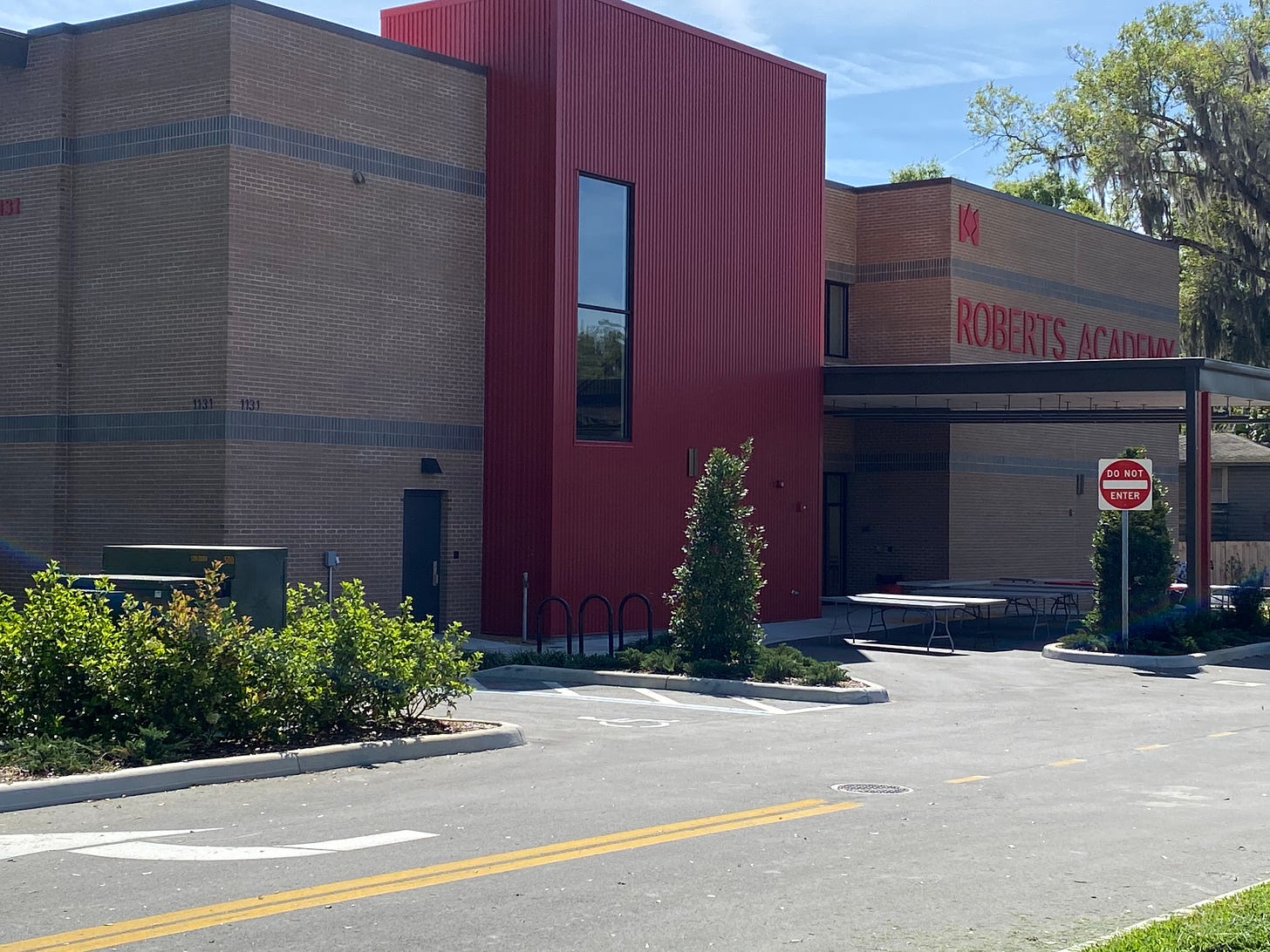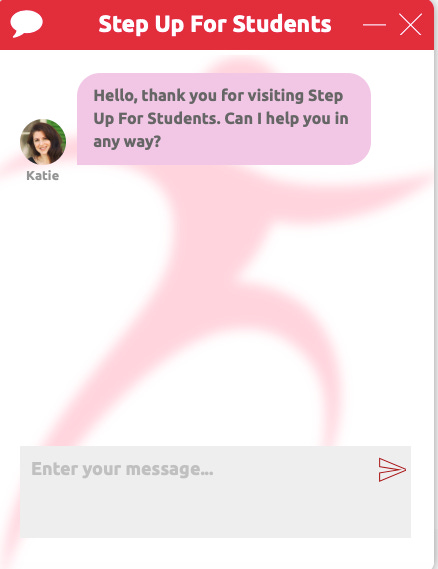Billy Townsend: Segregation Factories in Florida (Part 3)
Blogger Billy Townsend has been writing a series about vouchers in his state of Florida, and part three just dropped with his thoughts about “how to shop in a Jeb Crow voucher marketplace built to cheat and grift and harm your child.” This installment is not short, but it paints a picture of what it’s really like to go shopping in the Florida voucher school marketplace. It’s reposted here from his substack Public Enemy Number 1 with permission .
The smartest way to shop for a voucher school is not to shop for one at all. There are very very few worth buying. This is why the education savings account (ESA) concept is doomed as anything but grift.
When Kelli Stargel dismantles your educational Publix this legislative session and gives you a dollar store debit card for educational groceries instead, it doesn’t mean the dollar store gets anything better on its shelves. The dollar store doesn’t have the capital or product development systems that Publix has built over decades. The dollar store doesn’t have supermarket capacity.
There is almost nothing worth buying today in the ESA dollar store; and there will be almost nothing worth buying in the future.
Opaque grift inflation is coming; I have a tool to help
Testing and mass 3rd grade retention and forced busing away from neighborhood-turned-magnet-or-charter schools will keep driving vulnerable kids away from the capital of public schools (and eroding education capital and capacity for everyone, including the rich).
And the same group of grifter garbage voucher providers will just take more money from you, the taxpayers, to cheat and harm and segregate the socially, economically, and educationally vulnerable. The grifters will be able to charge them — and thus you — more money with an ESA.
That’s Jeb Crow boiled down to its essence. As I said in part 2 of this series:
If you’re poor or desperate or a person of color, your general education voucher (FTC) or ESE voucher (McKay and Gardiner) or ESA is very unlikely to buy a school spot or educational service that is not an open, dangerous scam. There just aren’t enough spots with reputable private providers — not anywhere close. Also, the voucher don’t come close to covering the cost of the few “good” private schools.
You’re gonna end up in a segregated, hideously low-quality grifter school instead. And then you’ll float back to public schools, grifted if you’re lucky — abused if you’re not. See Kingdom Prep.
A beleaguered and intentionally test-wounded public system is still far superior and possesses far more capital than all Jeb Crow schools and most private schools. In part that’s because local communities want it that way — and routinely vote that way, even in Florida. And because the alternative is mostly unimaginable grifty garbage.
But if you feel you must shop for a voucher school, I feel I must try to help you avoid getting grifted and harmed. No one else is going to help — certainly not unelected state Voucher Superintendent Doug Tuthill or unelected Voucher School Board Step Up for Students (SUFS) or the Florida Department of Education.
Let the buyer beware
You are completely on your own when you shop for a voucher school — except for Billy. I have a very helpful color-coded spreadsheet tool that I will send to any Polk family for free to help. My email address is bitown1@gmail.com.
If Step Up wasn’t an open grift of an organization, it would thank me for this consumer service I’ve performed to help its marketplace function better. If Step Up wasn’t an open grift of an organization, it would replicate this spreadsheet statewide and help parents read it. It would publish it as a navigation and purchase tool.
Instead, it’s about to make the already opaque and awful marketplace much harder to navigate. The state is about to kill individual and different voucher plans and collapse them into one giant cauldron of undifferentiated ESA grifter money.
You won’t be able to see which providers mix vouchers in the Step Up marketplace anymore — and use that as a quality indicator.
But you can use my spreadsheet of which providers do it now in Polk County — so you can avoid them in the future ESA griftopia, at least until they change their names.
The rest of this article explains how to read my spreadsheet.
Stay away from schools that mix types of vouchers. Unfortunately, almost all vouchers do; and ESAs will obliterate any difference completely
Start with this principle:
Taking all vouchers (McKay and Gardiner for disabilities/special needs; Florida Tax Credit and its offshoots for low income general education) is a giant red flag for any parent researching any voucher school. It should be a red flag for law enforcement and government, too.
Here’s what that looks like for a 100% black ESE student school that takes ESE vouchers while providing no ESE services — and remains branded in the Step Up for Students marketplace.
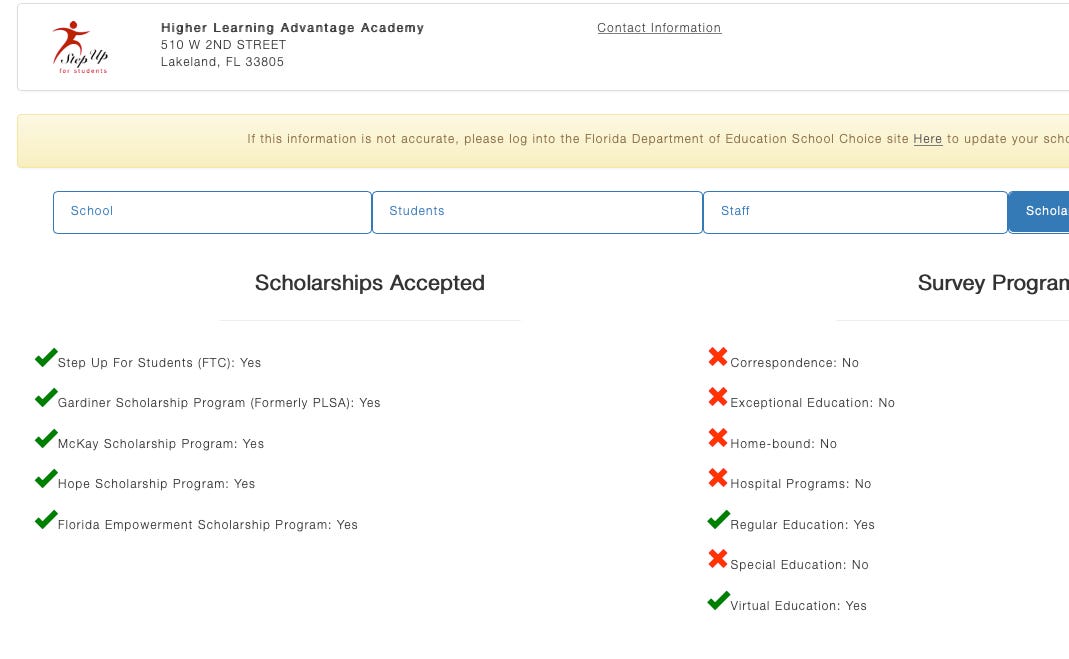
To be fair, most voucher schools that say they take special needs vouchers also at least claim to provide special needs/ESE services. “Higher Learning Advantage Academy” is pretty unique in claiming that it does not. That’s quite an innovation.
But “Higher Learning Advantage Academy” is not unique at all in mixing special needs and general education vouchers in student population structures that should not exist and pose danger to vulnerable children.
Indeed, all 15 of Polk’s most ESE-segregated voucher schools accept the general education Florida Tax Credit (FTC) voucher in addition to the disability-based vouchers known as “McKay” and “Gardiner.” See the field of green on the right, below:

Schools that mix those vouchers — and have oddly high or low ESE populations — just scream “GRIFT!!!” You should avoid them; and government should scrutinize them. Why? Because:
- FTC vouchers (and its Hope and Empowerment offshoots), in theory, fund “private” general education for poor and poor-ish kids.
- McKay and Gardiner, in theory, fund specific, specialized services for kids with clear disabilities.
Those vouchers shouldn’t mix, unless it’s in a school specifically and intentionallyattempting to do “inclusion” of kids with learning and/or physical disabilities with general education students.
Inclusion is really hard to do well and requires strong human supports and expertise to make it work, even in a public system that sees inclusion as a key ESE goal. Real inclusion does not happen in schools without sustained public or private capital investment and rigorous attention.
Real inclusion is a challenging goal for true public schools with public capital and ESE populations of 13 percent, which is about the overall ESE population for the Polk district.
Real inclusion does not happen at all with 45 percent ESE kids in voucher schools — much less 100 percent. Does. Not. Happen.
Those types of super concentrated ESE populations in the real public schools are found in “center” schools. They specialize in serving children with profound disabilities that make inclusion impossible. Center schools also require enormous resources because profoundly disabled children need close attention and care, often 24/7.
Do you think Higher Learning Advantage Academy has the capital or oversight to function as either an “inclusion” school or a “center” school? I’ll show you its pictures again a little later in this article.
I would immediately scratch 51 of 65 SUFS-branded Polk voucher schools off my list
To find a voucher school, you go through Step up for Students’ “Find your school” search portal. It takes you to a pin map and list of private schools in your area.

The search process is a little tricky; but my SUFS search produced 85 total Polk private schools, of which 65 carry the SUFS “brand,” as shown below on the left.

(The status of the other 20 “non-branded” schools is confusing to me. It has the hint of a disavowed school list because Pastor Tiger’s Kingdom Prep is on it. But it’s clearly not a fully disavowed list as you’ll see.)
Of the 65 “private” schools branded as Step Up for Students schools, 54 accept the McKay voucher, the Gardiner voucher, and the Florida Tax Credit (FTC) scholarship. That’s 83 percent — 83%.
As a Polk County ESE parent, I would rule out, on their face, all 54 of those schools — except Lakeland Christian School, Santa Fe Catholic High School, and Resurrection Catholic school. (I’d be suspicious of those 54 as a general education parent, too; but grifting ESE kids does not necessarily mean non-ESE kids get grifted. It could just mean the school is cruel to kids with disabilities and limits its grifting to the vulnerable — which likely says something about its morality and culture.)
The three schools I mentioned have the institutional capital/capacity to conceivably provide meaningful ESE inclusion and support in a general education-led setting. But I would do a lot of follow-up work to check on it. They also have normal-ish ESE populations. Lakeland Christian looks most normal at 13 percent. Resurrection is normal-ish (16%); Santa Fe is high, but not inconceivable. (22%)
Any normal standard public school with a 22 percent ESE population would be considered over-populated with ESE children — and a concern for the public district.
Yet, of the 27 Polk voucher schools with ESE populations of 22 percent or higher, only two have any accreditation of any kind. Santa Fe is one of them.
“Never even looked” at a McKay IEP
Schools that mix these vouchers — while having very large or very small (or zero) ESE populations tell me they’re serious about chasing money, not providing quality education services. And SUFS seems fine with that. It gets a cut from all of them.
Indeed, SUFS says 35 of its 65 branded schools in Polk have zero ESE population.
And yet, all but nine of those schools tell the public, through the SUFS marketplace, that they accept McKay and Gardiner vouchers for the kids that are not part of their population. That’s 26 schools that take ESE vouchers while not having any ESE kids.
Run away from that if you’re an ESE parent.
If you want a sense of how it works out for a McKay parent to try attend a school that takes McKay, but has no ESE students, here’s an account. A parent put this comment on my first “Segregation Factories” article. I’m taking the school’s name off because I haven’t personally verified the parent’s story. But I have no reason to doubt it. An IEP is an “individualized education plan.” It’s the plan for education or care for an ESE student that schools are supposed to follow. In real public education, failure to follow an IEP can cause legal sanctions for the public school district.
My son went to [a Christian academy with zero ESE population] in 2019-2020 he has McKay scholarship iep which they never even looked at when I enrolled him at this “private school” . My son was working thru work books since Aug at home due to covid I signed a scholarship check in November 2020 picked up two work works for him got email From principal/ owner that she was withdrawaling him due to him not completing enough books that was her answer and reasoning.
Step Up and Kelli Stargel would tell this parent: “You shouldn’t have made that choice with your voucher money, sucker. You got what you deserved. Woo Hoo, the market works. Let the buyer beware, baby.”
They would never think of telling that “Christian Academy” not to commit fraud by taking money for services it has no intention of providing. That’s because libertarianism is a personality disorder, not an ideology. I have the same of the school if anyone in law enforcement wants to investigate.
It’s also worth noting that the most reputable, high capital, general education private school for lower income kids in Polk County — Academy Prep — is clear that it does not have an ESE population and DOES NOT take McKay or Gardiner on the SUFS site.
I give it big points for honesty. If I was forced to pick a voucher school of any kind, I would choose Academy Prep.
Why is Roberts Academy not Step up for Students branded?
My second choice would be one of the Catholic schools or Florida Southern College’s Roberts Academy, which caters to kids with dyslexia.
There’s a weird wrinkle with dyslexia. Children who suffer from it are not officially considered ESE. I don’t think you can get a dyslexia IEP — but this gets so complicated that I’m hedging a little. Dyslexia students, as I understand it, are considered by law general education students.
I give you this background because here’s what Roberts looks like on the Step Up marketplace.
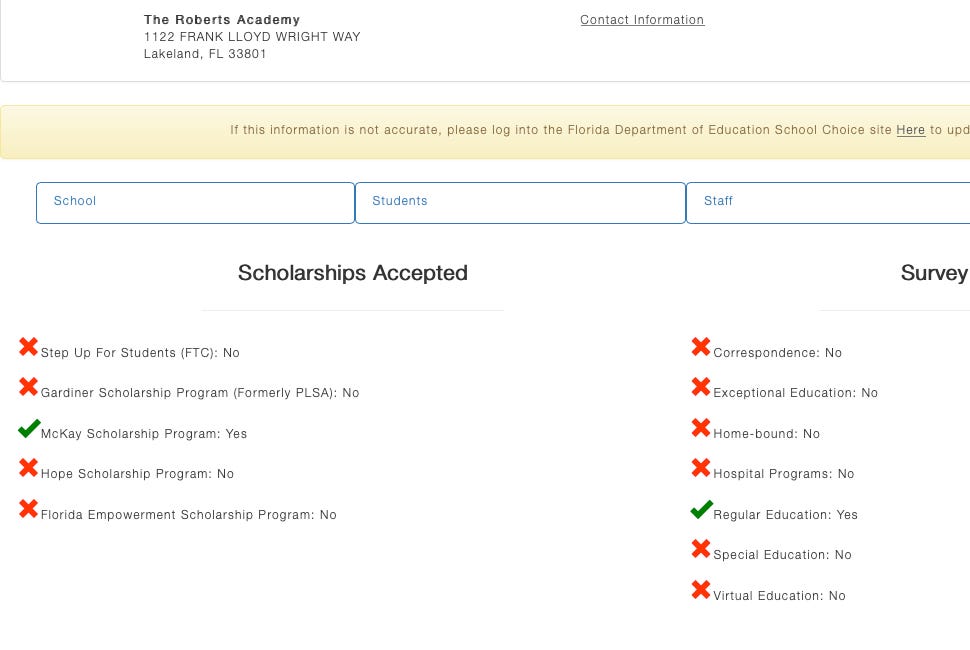
1) It’s not SUFS-branded in the way that Higher Learning Advantage Academy is.

Perhaps that’s because Roberts does not take the low income FTC voucher, which has a particular brand niche for Step Up. But there are at least two other schools that arebranded while not taking FTC.
2) Roberts only takes the McKay voucher. Roberts is literally the only voucher school in Polk County that only takes McKay. That doesn’t make much sense to me because McKay is tied to IEPs; and dyslexia, is not, to my knowledge, a disability that can generate an IEP on its own.
Maybe dyslexia is a common co-disability with disabilities that do generate an IEP. But I would think Gardiner would actually be a better fit for Roberts, at least on its face. Anyone from Roberts is welcome to clarify, but the SUFS marketplace says Roberts doesn’t provide ESE services — which, again, likely reflects the dyslexia oddity.
In any event, this is what SUFS marketplace tells parents; and I’m trying to put myself in a voucher or ESA shopping parent’s shoes and show you how hard it is to decipher.
Roberts only takes one voucher; Higher Learning Advantage Academy takes all five. So why do they look the way they do? Non-voucher capital
As with my previous articles on Jeb Crow education, it’s pretty visually instructive to compare what a racially-segregated ESE school with no capital looks like compared to an integrated-ish school for special needs kids with lots of capital.
This is Roberts, which only takes McKay, but has lots of non-voucher capital. It has two campuses across the street from each other.

Now take a look at entirely voucher-funded Higher Learning Advantage Academy. The second picture, its parking lot with a basketball goal, apparently doubles as its playground.
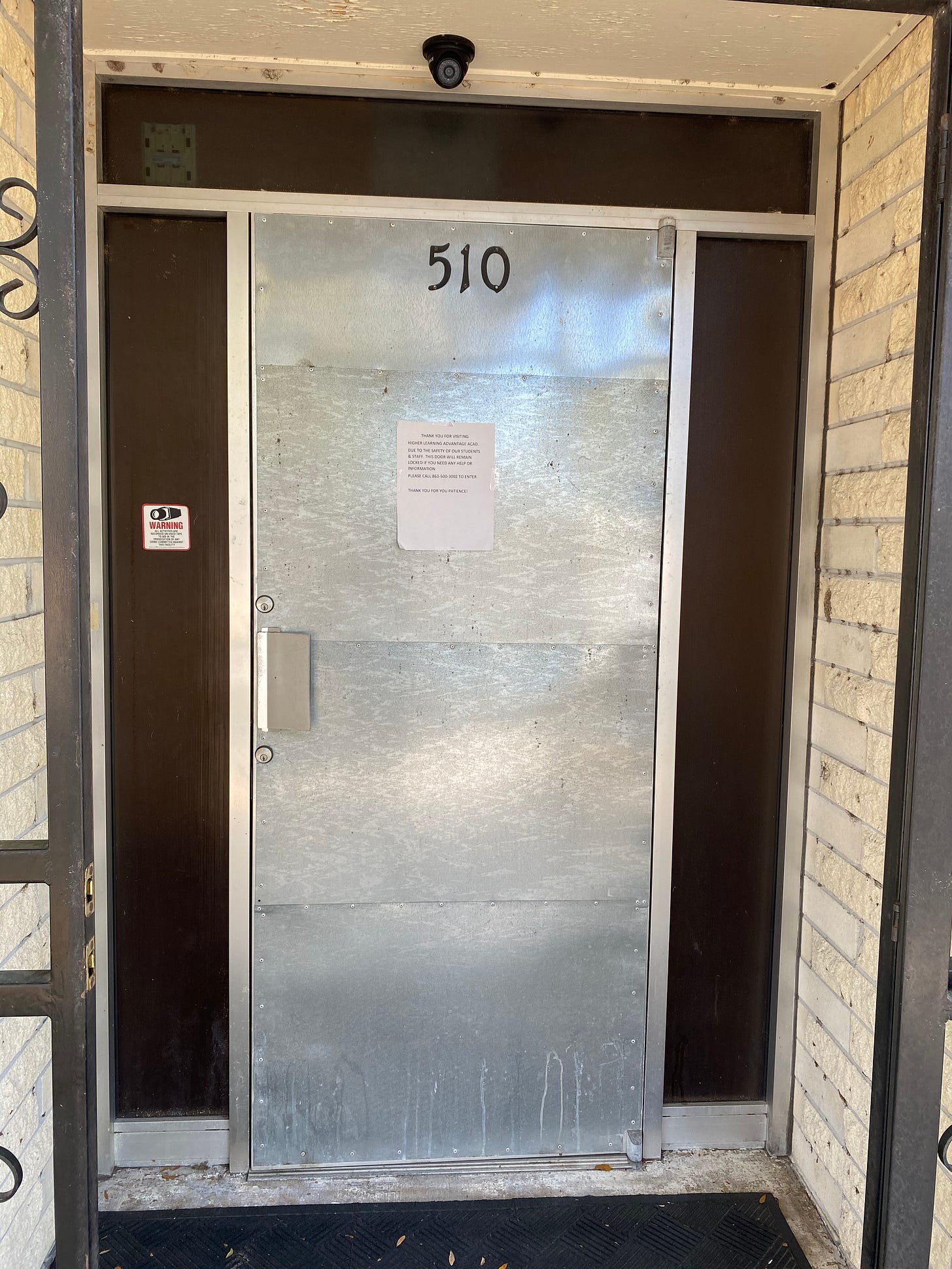
A marketplace with zero elements of a healthy market
Because I study this closely, I know SUFS is a con that doesn’t mean anything it says except: “give us our cut.”
SUFS spends apparently no time and money on overseeing its branded schools or cleansing the vendor information and data in the marketplace. It has, however, invested in annoying sales bots that swarm you as soon as you start searching for a school on the website. They want you to buy, not shop.
I hate to shatter people’s illusions; but I don’t think “Katie” is a real person. I once answered her question: “Nope”. To which “Katie” said, “Great I’ll connect you to an agent” or something like that.
This “market” is about grift, not function, so it sounds a little silly to me to make a serious economic/market-based critique. But I’m also weirdly obsessive about people who cheat and hurt people; thus few, if any, people pay as close attention to this as I do. I doubt anyone has ever done a voucher school spreadsheet like I did for their county.
So most people genuinely don’t understand how corrupt and cruel and dangerous all this is because the kids are out of sight/out of mind. People don’t know it at the consumer/shopper or the policy/funding level.
They don’t understand that Florida has a “market-based” education system that completely ignores any basic principles of a functioning market — transparency, legal accountability for fraud, standards for taking part in marketplace, ratings, etc. It’s pretty hard to pitch “Uber for schools” if you don’t even publish ratings/reviews for your providers.
Also, crucially, when people hear “private school,” they think Lakeland Christian, not Higher Learning Advantage Academy. And that is how SUFS gets away with it.
There is no supply for the ESA demand
But as we’ve seen — vouchers don’t buy Lakeland Christian. They buy Higher Learning Advantage Academy or Kingdom Prep or Endtime Academy or A’Kelynn’s Angels.
The disability vouchers — McKay and Gardiner — provide a lot more money per kidthan the low income Florida Tax Credit voucher program, which is typically what people think of when they think of vouchers. But the FTC vouchers are just meant to replicate general education. Their kids, in theory, don’t share any of the challenges of McKay or Gardiner.
So what happens when Kelli Stargel kills McKay and Gardiner and mashes them together with FTC and its offshoots?
Well ask yourself this: if you’re getting $10,000 from Gardiner for some specialized program and your money is mashed together with an FTC kid with a $7,000 general education voucher, then you both get an $8,500 ESA debit card. Who is that a good deal for? You, who loses purchasing power for your Gardiner child? Or the current FTC-kid, whose purchasing power goes up, but who still can’t afford Lakeland Christian or All Saints or a reputable general education provider because the ESA doesn’t provide enough money?
In fact, my question is probably irrelevant because no amount of purchasing power matters when there is nothing to buy.
No amount of demand-side money in education can create supply side capacity where it doesn’t exist — unless that capacity is a grift. ESAs will not create new Lakeland Christians or All Saints or institutional Catholic schools. In fact, by most accounts I’ve heard, over-dependence on vouchers is what killed St. Joseph’s Catholic School in Lakeland last year.
It shut down in May, although the Step Up for Students school search and marketplace portal still lists it as a functioning school with 187 kids.

Again, we see that vouchers don’t cover the full cost of per kid operations at any serious school; they create a capital deficit that must be made up privately. St. Joe’s couldn’t do it, apparently. It had been serving Lakeland kids since 1938. 1938.
Vouchers destroy education capacity; they don’t build it — either in private or public sectors.
If a person can’t teach physics, it doesn’t matter how much you pay them to teach physics. You need to invest the money either in hiring someone who can teach physics or in developing and training someone on staff to teach physics.
None of that capacity development in going to happen with ESAs.
State leaders are steadily eroding capacity in the public schools; but they still possess far far more capacity and capital overall than voucher providers. With very few exceptions, capacity does not exist at all in today’s voucher world — nor does any mechanism for developing it.
If a school is a low-capital segregated griftopia preying off ESE kids, it’s not going to invest your taxpayer-funded ESA money in the capacity to teach physics; it’s going to charge the taxpayers more for the grift it’s already grifting.
Your ESA won’t have anything to buy; but it will drive up the price of the garbage voucher schools that already exist.
Regulate voucher schools like banks because kids are as precious as money
Voucher school closures are a bit like bank runs — humanity runs, I guess you could call them. That makes public schools the FDIC of education.
Which leads to the question…why do we need an FDIC of education? Why do we want “schools” prone to disintegration? Who is “we”? Who benefits from bank run education other than the Tuthill family and other grifters?
¯\_(ツ)_/¯
Let’s pretend for a second that SUFS might read this and make its marketplace work. What would it have to do so it didn’t need an education FDIC to cover humanity runs at places like St. Joe’s? Four reforms to voucher provider eligibility would fix this quickly:
- Require accreditation by the same organization that accredits schools like All Saints and Lakeland Christian
- Require a meaningful capital/endowment-to-operations threshold
- Subject voucher school recipients to the same model of oversight that the Early Learning Coalition provides for state-funded Pre-K providers.
- Require that voucher schools take the same tests public schools take.
SUFS will never embrace these four entirely reasonable reforms, which are somewhat bank-like (especially the capital requirement), because they will kill voucher programs at any scale.
These common sense reforms would eviscerate the voucher/ESA provider network. If those four points were the standard for becoming voucher or ESA-eligible, only a tiny handful of providers would or could accept vouchers or ESAs.
This is the huge mistake voucher opponents have made for 20 years. They have pinned their hopes on conservative justices to enforce early 20th century church/state laws — which are rooted in ugly, violent anti-Catholic sectarianism. Legalism reflects a crippling lack of confidence and belief in the public schools we’re all fighting for.
The path to killing vouchers has always been to reform the provider network that takes them — and kill the political testing that herds kids into those “schools.” As I’ve said, nothing discredits vouchers like vouchers. It’s why FTC has a 61 percent 2-year drop out rate.
I personally do not care if vouchers live or die as a legal/educational concept. I care about capacity and quality and equity of education services available across the community.
I would prefer that at least the intent of McKay and Gardiner remain as funding available for closely regulated, high quality private services for children with complex needs. Actual human beings benefit from that.
And if a few kids go to Lakeland Christian or All Saints or a couple of accredited Catholic schools using an FTC voucher program small enough to drown in a bathtub, I could live with that and consider my market-based reforms a success.


